what do you get when you add black to a hue (color)?
07. Hue, Value, and Saturation
Objectives
Through this assignment you'll focus on examining the deviation between hue, value, and saturation, which can commonly go mixed upward with one another. Past the finish of this week you should be able to articulate the difference between the two and prove that agreement in your work.
Lecture
In short, going back to 1 of our first assignments, delight remember that color is the visual byproduct of the spectrum of light as it is either transmitted through a transparent medium, or as it is captivated and reflected off a surface. Color is the light wavelengths that the human center receives and processes from a reflected source. In our course, nosotros are using acrylic paints so we are dealing with color equally it is captivated or reflected dorsum to our eyes. (The digital and film realm, including photography, deals with transparency.)
Color consists of three primary integral parts:
- Hue
- Value
- Saturation (also sometimes chosen "blush')
We will explore these in more than particular below. All of the definitions and explanations utilise to the light assimilation method.
1. Hue
Hue is more specifically described by the ascendant wavelength and is the get-go item nosotros refer to (i.e. "yellowish') when adding in the three components of a color. Hue is likewise a term which describes a dimension of color we readily feel when we look at color, or its purest grade; it essentially refers to a color having full saturation, equally follows:
When discussing "pigment primaries' (Ruby-red, Yellow, and Blue), no white, black, or gray is added when 100% pure. (Total and complete desaturation of a hue is equivalent to true black.)
2. Value
Value refers to the lightness or darkness of a color. It indicates the quantity of light reflected. When referring to pigments, dark values with blackness added are chosen "shades' of the given hue proper name. Light values with white pigment added are chosen "tints' of the hue name. Value just refers to the lightness or darkness quality of a color. If a color is called "low value", that means information technology is darker in nature – think closer to the earth (dark soil) – and if it is chosen "loftier value" that ways information technology is lighter in nature – think closer to the whitest, brightest sky.
In a standard color cycle, like the ones we first started out with, the colors shown are considered "mid value". They are representations of color visually judge to beingness in the middle center of a value scale.
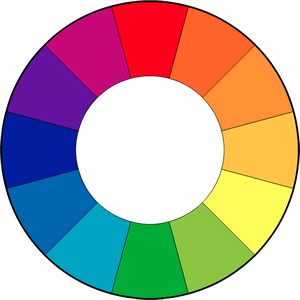
For a physical example of how to utilize these terms correctly, let's focus on the primary red. A mid value red would announced as the ruddy to a higher place show in our color wheel. A high value scarlet would have much more than white mixed into it and appear equally a calorie-free pinkish. A low value crimson would have a darker appearance. This can exist accomplished by mixing some black into information technology, or mixing the complementary of ruby-red into it, which would be dark-green. The upshot nosotros exist a night red that would read either as a deep rust or a muddy brownish, depending on the quality of the pigments existence used. (I personally adopt to mix my own darks via complementary colour combinations rather than using blackness straight out of the tube. The results in term of hue complexity will be much more sophisticated. Blackness straight out of the tube can be very shallow in hue and can accept a graphically flattening consequence in painting.)
iii. Saturation
Saturation defines the brilliance and intensity of a colour. When a hue is "toned,' both white and black (grayness) are added to the colour to reduce the color'south saturation. When a colour has high saturation, the pigment intensity is vivid and brilliant. When a color is desaturated, or low saturation, the color appears to be "greyed out" or muted. Delight note graphic beneath to help visualize what a desaturated principal ruby-red would look like. (Run into the 2nd row, right paw side.)

Desaturation is probably a tool yous've already been using in your ain work but may not have come across the technical term for it before. Accept y'all always used atmospheric perspective in your work? If so, y'all've been using dissimilar saturation levels in your hues to create a convincing illusion of depth in your landscape work. Portions of the mural that are supposed to be closer to the viewer will be more saturated and more than detailed, whereas portions of the landscape that are supposed to be further away from the viewer are less saturated (desatured) and less detailed.
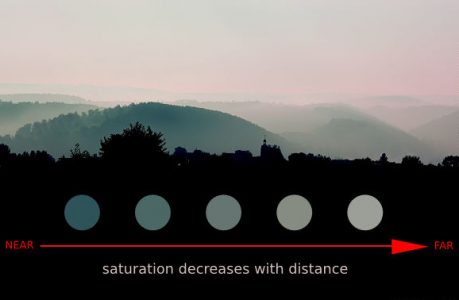
Action
This calendar week'due south assignments will all be in your journals so nosotros can salve your larger mixed media paper for our remaining assignments.
- Please exercise a seven square value calibration for each primary (RYB). These three can be done on the same folio if yous have room to do and then. You can reference the graphic above for inspiration, simply here is a pupil instance of a 7 foursquare scale that might be more concrete:
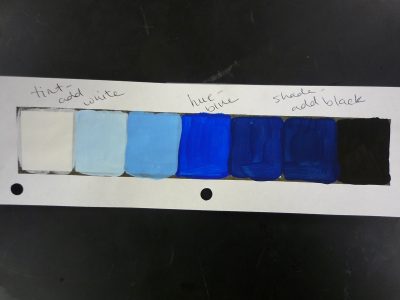
Why seven squares? An odd number scale makes this assignment much easier since the middle of the scale tin can be the mid value colour. And so adjacent you'll desire to execute your highest and lowest values so each end of the scale is at present identified. Then patiently mix your colors for the remaining squares so that each step looks visually even. Please note that if you desire a color to wait 50% xanthous, for example, and fifty% white the bodily mixing process volition non be 50/50. We desire the hue to read that fashion, only since yellow has a much weaker pigment strength than blueish or red, it can be hands overwhelmed. The opposite is true for primary blue. You'll often need less blue and a bang-up deal of white to make it read equally l/l.
- Please do a similar vii square desaturation scale for each primary.
- On a split folio, please utilize your newfound – or recently rediscovered – agreement of hue, value, and saturation to create a uncomplicated atmospheric perspective painting. By unproblematic I mean focus in a straightforward way on how these can be utilized to create an illusion of space. It is non necessary to go into dandy particular to have a narrative in this painting, such as a motel, campfires, figures, etc. in the foreground or whatsoever other part of the painting for that matter. (Although you're more than welcome to do so if yous wish!)You are non express to just one hue for this exercise. It should be fun, and then please go every bit artistic as you like. Here are a few general examples of what would be successful for this component:

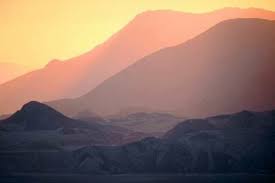
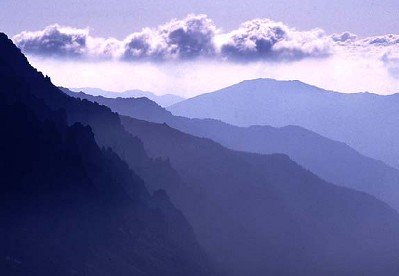
- Please post a photo your results in the comments section of the correlating posts.
Source: https://coloranddesign.community.uaf.edu/07-hue-vs-value/

0 Response to "what do you get when you add black to a hue (color)?"
Enviar um comentário